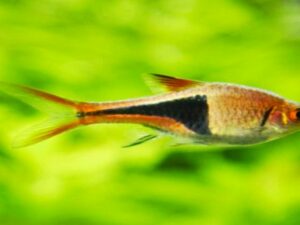Saltwater aquariums are home to many different types of invertebrates. Bristle worms are one of the most common invertebrates found in saltwater aquariums.
Bristle worms are segmented creatures that can grow up to 12 inches in length. They get their name from the many bristles that cover their bodies.
In this article, You will get answers to most of the questions about Bristle worms. Many people have confused and can not determine whether they are good or bad for your tank or if they are likely to cause any harm to your fish.
Things that should be done in case your tank gets infested by these. What are the causes, and how do they enter your tank?
What effect do they have on your tank, aquarium plants, other decorations, etc.? We are here to try our best to give you the information you need about these worms.
Sometimes they can be misunderstood as fireworms. We will provide you with the information you need to understand which is a bristle worm, which is a fireworm, and which among these two is suitable for your tank. So let’s get started!
Check Easy Methods To Prevent and Remove Detritus Worms
Table of Contents
Bristle worms
Bristle worms are a type of segmented worm that comprise the Polychaeta, which means “many hairs,” class of animals. They get their name from the bristles (or setae) covering their bodies. They belong to the phylum Annelida and are closely related to earthworms and leeches.
There are over 10,000 different species of Bristle worms; over 98% of them are found in saltwater. Only about 200 species are found in freshwater. Their size can range from a microscopic to more than 50 feet in length.
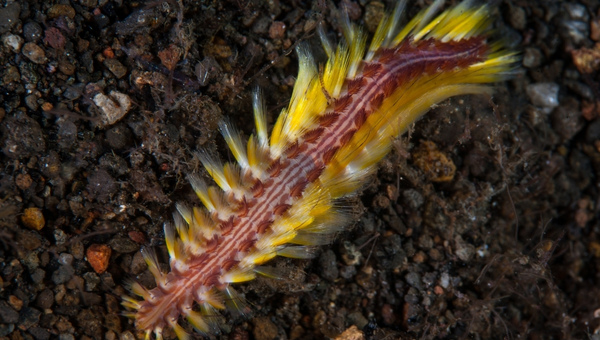
They can survive both in hot and cold water. Aquariums can range between 3 to 10 inches long, but some can reach up to more than 2 feet.
Bristle worms have a segmented cylindrical body. They have a head with eyespots and two antennae. Each segment has a pair of jointed appendages called parapodia that project laterally from their bodies.
These parapodia are used for locomotion as well as for capturing prey. The bristles (setae) that cover their bodies help anchor themselves in the substrate and protect them from predators.
The color of Bristle worms can vary depending on the species. They can be red, green, white, orange, or brown. Some species are also brightly colored.
The bristle worm’s head has eyespots that help them to detect light. They also have two antennae which they use for locomotion and for sensing their surroundings. Their mouth is located at the bottom of their head, and they have a sharp jaw that helps them to capture prey.
The bristle worm’s circulatory system is closed, and they have a two-chambered heart. They breathe through their skin. The nervous system of a bristle worm is similar to that of an earthworm. They have a brain and a ventral nerve cord. Each segment of their body has a pair of ganglia.
Bristle worms can be divided into two orders: errant and sedentary. Errant Bristle worms are those that move around actively in search of food. They have well-developed parapodia and setae.
Sedentary Bristle worms live in tubes or caves and do not move around much. They have poorly developed parapodia and setae.
Bristle worms are found in all habitats, including marine, freshwater, and terrestrial environments. They are located on all continents except Antarctica. In marine environments, they are found in the intertidal zone and the deep sea.
Bristle worms are primarily scavengers and detritivores. They feed on dead and decaying organic matter. Some species of Bristle worms are also predators and feed on small invertebrates.
Bristle worms are hermaphrodites. This means that each individual has both male and female reproductive organs. They reproduce by cross-fertilization.
The eggs are fertilized by the sperm of another individual and are then deposited in the environment, where they hatch into larvae. The larvae go through a process of metamorphosis before they become adults.
Also, check Butterfly Betta Care Guide: Appearance, food & Diet, Breeding & All.
Bristle worms vs fireworms
Bristle worms and fireworms are both members of the phylum Annelida. They are segmented worms that have cylindrical bodies. They also have a head with eyespots, antennae, and a mouth.
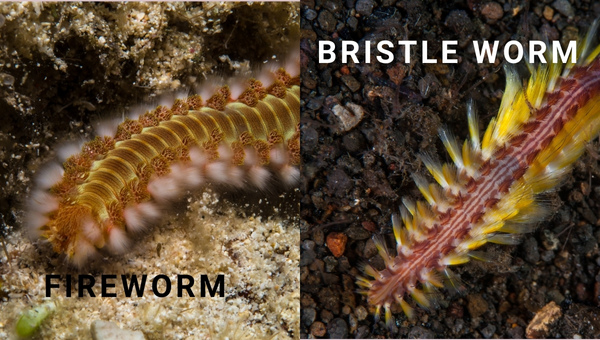
Fireworms are a type of Bristle worm. They have many similarities but many differences as well. We need to understand the difference between these two because one is suitable for your tank while the other is not. Let’s read further to find the difference.
Also, check Panther Grouper Care Guide: Appearance, Lifespan & Coloration & Breeding.
Some Important things to know about Bristle worms
Here, we will discuss their benefits and share how to eliminate them.
Which ones are beneficial and why?
Bristle worms are generally beneficial for your saltwater tank. They help to keep it clean by eating algae and other detritus. They also aerate the substrate and help to break down organic matter.
Bristle worms have hair on their body; if you touch them, it might feel like a bee sting, but they are primarily suitable for your tank.
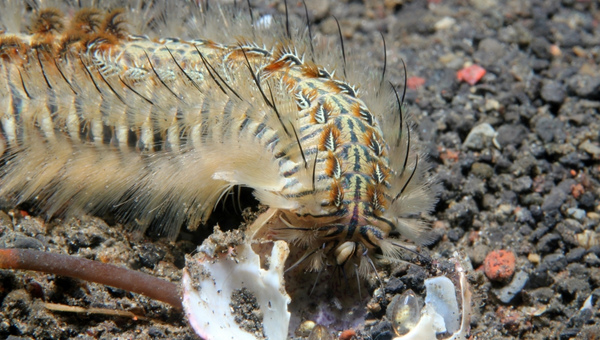
Bristle worms are scavengers, so they will not harm your fish or other tank mates unless they are sick or dying. If you see a bristle worm eating one of your fish, you know that the fish is already ill or dying. They will help you keep your tank clean, just like species of snails can.
They can be termed as friends of your saltwater aquarium. The species that benefit your aquarium are fragile, can get in every nook and crack inside your tank, and will work better than any scavengers.
Bristle worms are not fussy eaters. They will consume anything from algae to uneaten food and fish waste. Most species of Bristle worms feed at night and will also eat any detritus.
The population of Bristle worms, even the good ones, can increase rapidly. It depends upon how much food they consume. The more they eat, the more they reproduce. To keep their population under control, try not to overfeed them. Otherwise, your tank might get overflowed by Bristle worms.
You can tell the difference between good and bad Bristle worms by looking at them carefully. The good ones are very thin and have small bristles all over their bodies. Destructive Bristle worms are giant and have sharp spines on their body.
These spines can grow up to an inch long and be dangerous for your fish and other invertebrates. Destructive Bristle worms will have prominent, evenly spaced white bristles all over their body, while the good ones are not prominent.
Some people might not want Bristle worms in their tanks because they fear them. But you should know that Bristle worms are not harmful unless provoked. Most of the time, they will mind their own business and stay hidden in your substrate.
Check How To Cure Fish Fungus (Aquarium Fish) Ultimate Treatment & Medication
Which ones are bad for your tank?
Fireworms are not as beneficial as Bristle worms because they will destroy your tank. They are not picky eaters and will consume anything in their path. Fireworms are also known to sting humans, so you should be careful when handling them.
The family of Bristle worms known as Amphinomidae, also called fireworms, have toxin-containing hollow bristles that burn when touched. The bristles are used for both offense and defense. When the fireworm feels threatened, it will arch its body and reveal its bristles.
If you touch these bristles, they will release toxins that can cause skin irritation and swelling. In some cases, the toxins can be deadly if injected into the bloodstream.
Fireworms mostly attack fish when they are asleep, which is even worse. They have sharp spines on their body that can grow up to an inch long.
These spines can puncture your fish’s skin and make them sick. Fireworms will also eat your other small fish and other invertebrates like crustaceans and Mollusca.
Fireworms can be more significant than Bristle worms in size. They can be found in a variety of colors. They will be slightly more brightly colored than Bristle worms. They will have white and red and white bristles have short tufts.
Fireworms, just like Bristle worms, can reproduce at a very fast pace. Their population can increase. This means they can be very dangerous to your tank.
They will grow in number and will ultimately damage your tank. It is better to eradicate them as soon as you see them before they can cause any damage.
You may also check Cardinal Sulawesi Shrimp 101: Care Guide & Breeding Guide.
Ways through which bristle gets into your tank?
Bristle worms can get into your tank in many ways. They can be in live rock or sand that you add to your tank. They can also hitchhike on the live food that you feed your fish. You can also introduce them into your tank if you buy a coral frag with Bristle worms.
Also, check Pipefish 101:Care, Appearance, Diet, Breeding, Lifespan & All
How do you get rid of them?
We suggest you don’t get rid of the good Bristle worms, as they are suitable for your tank. Unless they don’t reproduce profusely, try not to get rid of them. You should keep their population in a tank to maintain a healthy environment of our tank.
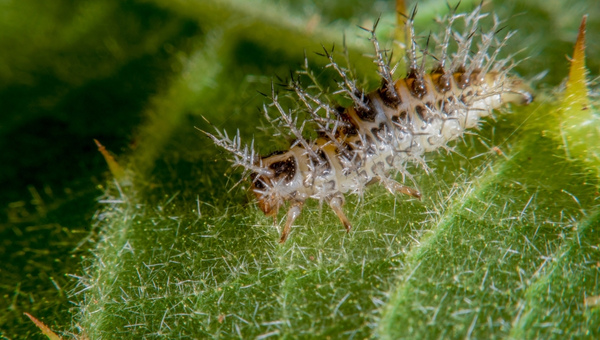
Getting rid of Bristle worms is difficult once they are in your tank. This is because they can reproduce very quickly, and their eggs can survive in harsh conditions.
The way to prevent them from getting into your tank is to quarantine all new additions for at least a month before adding them to your main tank.
If you find out that your tank has been under attack by Bristle worms, you can follow the methods given below and choose according to your needs:
Introduce organisms that eat worms and are beneficial for your tank
One way that will help you and is not high maintenance is to introduce predators that eat these worms.
- The first predator that you should consider is the arrow crab. These crabs eat all kinds of worms, including Bristle worms. They are also not very high maintenance and are suitable for your tank.
- Another predator that you can consider is the tiger shrimp. These shrimp are known to be voracious eaters and will help you get rid of the Bristle worms in your tank.
- You can also consider introducing a wrasse fish into your tank. These fish are known to eat all kinds of worms and are very effective at getting rid of them.
- Other options include introducing a coral-banded shrimp or a scooter blenny into your tank.
Check Ultimate Dragon Goby 101: Care, Appearance, Food, Habitat & All
Use a bristle worm trap
You can also use a trap to eliminate the Bristle worms in your tank. There are several traps that you can use for this purpose.
- The first type of trap is the Bristle worm trap. This trap is made specifically for catching Bristle worms. It is a very effective trap and can help eliminate the worms in your tank.
- Another type of trap that you can use is the bottle trap. This trap is straightforward and very effective at catching Bristle worms.
- You can also use a cup trap to catch these worms. This trap is also straightforward to make and is very effective.
Also, check Tomini Tang Fish Care Guide: Appearance, Breeding & All
Use chemicals to kill the worms
You can also use chemicals to kill the Bristle worms in your tank. You can use some chemicals for this purpose, but you have to be careful that these chemicals do not affect other members of your tank.
Ensure you are adequately using the following chemicals after doing your research.
- The first chemical that you can use is potassium permanganate. This chemical is very effective at killing worms and safe to use.
- You can also use bleach to kill the Bristle worms in your tank. This chemical is very effective at killing worms but is very toxic and should be used cautiously.
- The first chemical that you can use is borax. This chemical is very effective at killing Bristle worms.
- Another chemical that you can use is vinegar. This chemical is also very effective at killing these worms.
- You can also use hydrogen peroxide to kill the Bristle worms in your tank.
You may also check Freshwater Flounder Care Guide: Appearance, Diet, Breeding & All.
Handpicking
If you have a small number of worms in your tank, you can handpick them and remove them from your tank. This is a very effective method but is very time-consuming.
For hunting them down with your own hands, you can use a small net to scoop them out or use a pair of tongs to remove them.
Ensure you are tanking the entire worm out of the tank, as they can quickly regenerate. Be very careful while taking them out, as they can sting you.
After removing the worms from your tank, ensure you dispose of them properly so they cannot get back into your tank.
If you think that any worm is stuck on a rock or other thing inside your tank, then take that piece of rock out and place it in fresh, dechlorinated water. The worm will separate, and then you can get back to the business of killing them.
Also, check Cherry Shrimp Care Guide: Appearance, Food & Diet, Lifespan & All.
Are you ready to handle them?
You can use these methods to eliminate the Bristle worms in your tank. You have to decide which way is best for you and your tank.
Remember that not all worms are dangerous for your tank. Some can be very harmful to your fish and other members of your tank, so getting rid of them as soon as possible is essential.
It is best to research and determine what works best for you. If you want to keep the beneficial worms or not, what methods do you wish to choose to deal with the destructive worms, etc.?
The main goal is to maintain the health of your saltwater tank, and it is up to you to decide what works for you. Be prepared and do your best to help your saltwater aquarium family thrive. Thanks for reading



